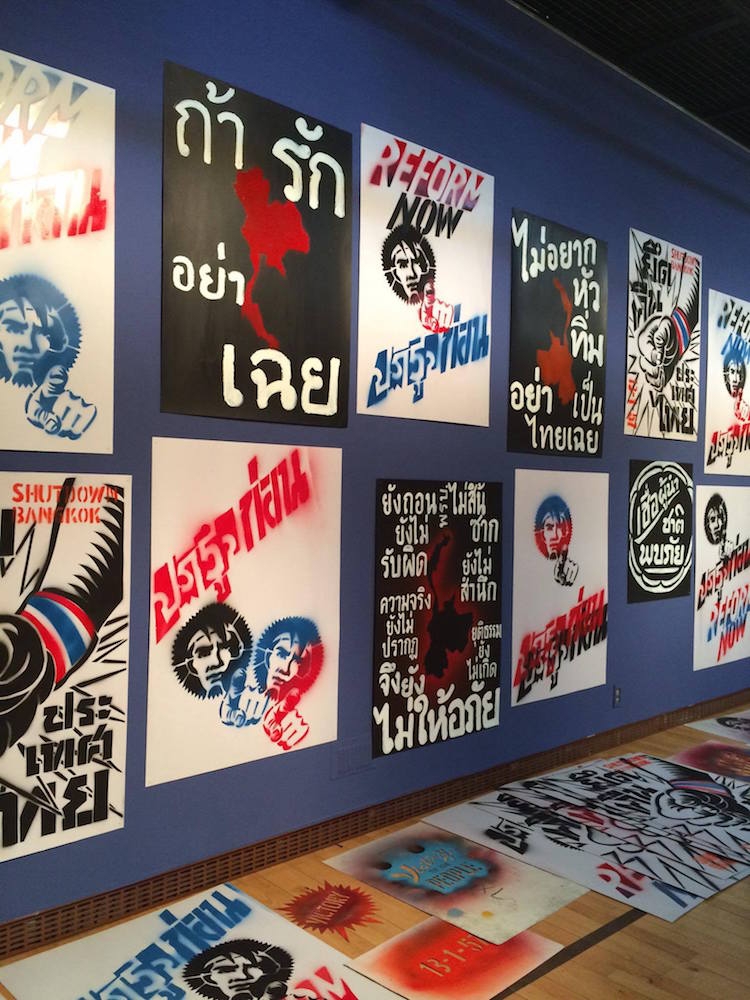‘The art world here, already small, shrinks further, divided now by a rift unlikely ever to heal,’ wrote filmmaker Ing Kanjanavanit on her blog Bangkok Love Letter last June. The ‘art world’ is Thailand’s, and she was responding to a public debacle that had emerged the month before about the inclusion of artist Sutee Kunavichayanont in an exhibition that celebrated democracy, human rights and peace in Asia. The exhibition, held at the Gwangju Museum of Art in Korea, was titled The Truth to Turn It Over, and had been organised to mark the 36th anniversary of the Gwangju Uprising.
Kanjanavanit’s comment was prescient. Nearly six months later, there have been no signs of any local bridging of the rift between those who complained about and those who defended Kunavichayanont’s inclusion in the exhibition, the former alleging that his ‘anti-democratic’ politics meant that his work was incompatible with an exhibition staged to promote ‘Asian democracy, human rights, and peace’. While the museum, in a concession to the importance of this debate, did agree to post notices of the various accusations and counter-accusations alongside the artist’s installation, factions in Bangkok have not publicly sought common ground.
To recap events: a group of more than 200 people in Thailand calling themselves Cultural Activists for Democracy (CAD) circulated an open letter in May claiming that Kunavichayanont could be linked to a conservative protest movement, the People’s Democratic Reform Committee (PDRC), which arguably laid the ground for the 2014 military coup d’état that brought down Yingluck Shinawatra’s democratically elected government. Thailand remains under military rule. Kunavichayanont denied the claims, arguing that he opposed alleged corruption in Shinawatra’s administration, one of the claims of the PDRC. An open letter – eventually joined by hundreds of signatories – by artists Manit Sriwanichpoom and Vasan Sitthiket defended Kunavichayanont and reiterated that corruption breeds its own problems and might legitimately necessitate opposing an elected government. While CAD could gleefully highlight the circumstantial facts of Kunavichayanont’s relationship to the protesters (who did indeed get what they asked for), Sriwanichpoom and Sitthiket pleaded for an understanding of ‘purehearted’ citizens.
The artist’s works are agitprop with slogans such as ‘Reform Now’ and ‘Seize Thailand’. CAD claim that Kunavichayanont contributed to fundraising efforts for PDRC through a commercial venture titled Art Lane. More controversially, the dating of some of his works from 2014 could link him to the ‘Bangkok Shutdown’ protests that paralysed central Bangkok, called for a boycott of a free election and blocked voting booths.
If, following Kanjanavanit’s thinking, there is a rift in Thailand’s artworld that is unlikely to be healed, is anyone asking how it could be healed?
Sriwanichpoom and Sitthiket’s essential defence of the reputation of Kunavichayanont is relative to the fact that CAD appeared to pursue a personal indictment of the artist, which in turn highlights the absence of an account of how art itself becomes implicated in national politics. Here one could point to the history of Kunavichayanont’s practice – and Sriwanichpoom’s and Sitthiket’s – as participating in the ideologies of historic governments that Shinawatra and her cronies were widely accused of attempting to change. That is, these artists always speak to an ‘everyman’, whether Kunavichayanont’s early melancholic engagement with national symbols through his series of deflated latex elephants and silicone Siamese twins or Sriwanichpoom’s Pink Man imagery about the general problems of consumerism or Sitthiket’s endless rage-againstauthority that could galvanise fascists and liberals alike. Insisting on a unified public, a definable political position, has been the agenda of many of Thailand’s leaders. Shinawatra, as the media story endlessly replays, was seeking to change the profile of that public, that position or that ‘everyman’ to one less beholden to traditional Thai hierarchies of class and privilege.
The standoff between CAD and the others points to a certain need in Thailand to learn to parse the relationships of art to political cultures, to trace, for example, how the histories of the practices of Kunavichayanont et al are already embedded within the interests of longstanding elites. But, ultimately, who cares? At issue is not an artist’s personal political affiliations but an understanding of how art can be related to contexts and systems that are not of its making, and how meanings can be shaped that are not reducible to intention. Without this understanding we have the zero sum game, as here, of accusation, denial and counter-accusation providing the order of exchange. In this respect, it is surely the current job of artists in Thailand, and concerned cultural activists, to render contexts and systems anew, or strange. Otherwise we are left with the potential for rifts that, highlighted and reinforced by Kanjanavanit’s observation, cannot be healed, because no one seems to understand how to manage the problems.
From the Winter 2016 issue of ArtReview Asia
